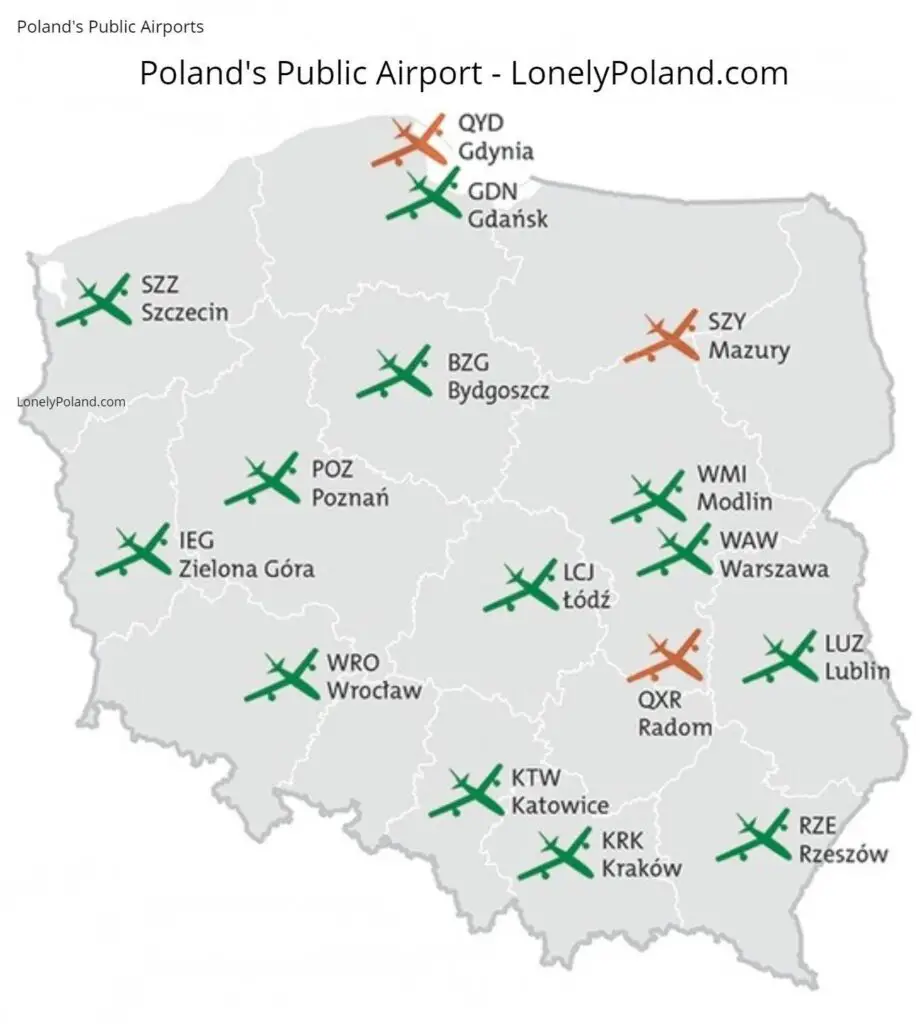Flying by plane has recently become quite popular. I believe it’s because planes are considered to be fast, safe, and affordable means of transport. If you want to spend holidays abroad, the easiest way to get to distant warm places is by plane. In this blog, I will share some insights about airports in Poland and where Poles fly most often.

Airports in Poland – List and Maps
Poland’s civil airport system, used for passenger transport, consists of 15 airports. I can tell you that the Chopin Airport plays a dominant role among these, with the remaining 14 being regional airports.

Chopin Airport in Warsaw – The Largest Airport in Poland
I am convinced that no one will be surprised to learn that the largest airport in Poland is the Chopin Airport, located in the capital (Warsaw). For many years, this airport was privileged by the state authorities, limiting the development of other airports in the country. Warsaw was supposed to be a transfer hub for Poland. However, it is worth to say that the role of the Warsaw airport will gradually decrease as traffic to other regions develops.
Regional Airports in Poland
Regional airports refer to the network of airports that were supposed to play an auxiliary role to the capital airport in Warsaw. They were designed to receive passengers coming from abroad or flying abroad via Okęcie. In 2004, the aviation market was liberalised, leading to regional airports developing their own international connections, mainly based on low-cost airlines like Ryanair, Wizz Air, and easyJet. Currently, only three voivodships (Opolskie, Podlaskie, and Świętokrzyskie) do not have airports.
A Complete List of Public Airports in Poland
If you need to know where the airports are located, here’s a list of cities with their respective airports:
- Warsaw – Okęcie
- Warsaw – Modlin
- Krakow – Balice
- Gdańsk – Rębiechowo
- Katowice – Pyrzowice
- Wrocław – Strachowice
- Poznań – Ławica
- Rzeszów – Jasionka
- Szczecin – Goleniów
- Lublin – Świdnik
- Bydgoszcz – Szwederowo
- Łódź – Lublinek
- Olsztyn – Szymany
- Zielona Góra – Babimost
- Radom – Sadków
Small Airports and Landing Sites
The map of airports in Poland provides crucial information about landing sites, such as GPS coordinates, runway location, ICAO code, landing direction, runway dimensions, radio frequency, runway threshold, and slope.
More Than Just Airports
The map below also covers grass, glider, and model airfields. Selected airport zones are conveniently marked for easy identification. Some airports on the map come with a detailed description of the approach, obstacles on the way, and landing notes and tips. Additionally, you’ll find information about interesting and useful places within the airport, such as gas stations, accommodation, and restarants.
Below, you will find another version of the map. When you click on the DOT, you will see the codes and landing site data.
Polish Airports and Passenger Services
Let me tell you about the performance of regional airports in Poland in recent times. There are two groups of airports, with six in the first group, including the largest regional airport in Krakow. This airport saw 7.39 million travelers, followed by Gdańsk with 4.57 million passengers and Katowice with 4.41 million travelers. The fourth largest regional airport in Poland in 2022 was Warsaw-Modlin, which had a record-breaking result of 3.12 million passengers. Next up were Wrocław, with 2.87 million passengers, and Poznań, with a result of 2.25 million.
Smaller Airports Making Big Strides
The second group of airports included seven more. Rzeszów-Jasionka topped this group, serving 731,000 passengers and playing a key role in handling cargo flights supporting Ukraine during the Russian attack. The other airports in this group were Szczecin with almost 420,000 travelers, Lublin with 330,000, Bydgoszcz with 254,000, Łódź with 180,000, Olsztyn-Mazury with 113,000, and Zielona Góra with 43,000 travelers.
According to paszer.com, not all airports developed at the same pace. Small cities like Zielona Góra and Łódź performed best, seeing traffic increases of over 24 percent and over 17 percent, respectively, compared to 2019. Lublin and Rzeszów also did well, achieving over 92 percent of their 2019 volume. What’s interesting is the comparison of the largest airports’ achievements. Warsaw-Modlin was the only one to improve its result from the year before the pandemic, by 0.7 percent. Poznań performed well, losing only 5.3 percent compared to 2019, while Katowice ranked third with a 7 percent loss. The other four airports recorded double-digit declines, with Chopin Airport in last place, not reaching 80 percent of its 2019 pasenger numbers.
The Importance of Regional Airports
The president of ZRPL, comments, „It was an important and good year for Polish regional airports”.There has been a rapid recovery of passenger transport, crucial for stabilizing the financial situation of ports. Polish citizens showed their preference for regional airports, which they know well and find affordable. In fact, two out of three airline passengers served in Poland chose regional airports last year.
Tomasik adds, „The first year after the crisis showed that regional airports continue to play an important role for the sustainable development of the country”.These airports are also a vital part of the state’s transport infrastructure, as they took care of the majority of aid for Ukraine that arrived in Poland by air, particularly at airports in Rzeszów, Lublin, and Katowice.
References:
- https://radarowo.com/lotniska-w-polsce/
- https://pl.wikipedia.org/wiki/Lotniska_w_Polsce
- https://lotniska.dlapilota.pl/



